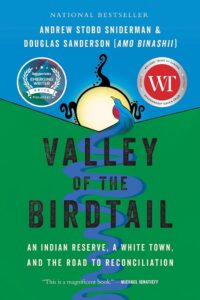Book review: Valley of the Birdtail: An Indian Reserve, A White Town, and the Road to Reconciliation
 Reviewed by Karl Hele
Reviewed by Karl Hele
Sniderman and Sanderson in Valley of the Birdtail: An Indian Reserve, A White Town, and the Road to Reconciliation offer an exploration of two neighbouring communities in Manitoba nestled in a shared valley, yet seemingly miles apart. The work follows the history of the First Nation community of Waywayseecappo and the neighbouring Euro-Canadian town of Rossburn. Each chapter, as the history and contemporary experiences unfold, presents a dual narrative of experiences – Settler and Anishinaabeg. In following the two stories, Sniderman and Sanderson ably show the discordant, and very occasionally similar, experiences of the Anishinaabeg and the Ukrainian settlers in the Birdtail Valley. For example, the discordance is seen through work of the Minister of the Interior Clifford Sifton; he welcomed Ukrainian settlers to the prairies, offering cheap land and assistance in creating farms, whiling undermining First Nations farming and denying them land. Other discordant stories focus on the Federal Government purposely underfunding First Nation education that resulted in a disparity in educational experiences between white and Indigenous children.
Valley of the Birdtail also discusses the assumptions within the Euro-Canadian community about the supposed benefits – free education and no taxation – ‘given to the Indians’ alongside the supposed reserve corruption. According to Sniderman and Sanderson, these supposed ‘truths’ were born of government policies of isolating Indians from white communities, as well as underfunding the former, which resulted in an invisible but tangible border between neighbours born of ignorance and lack of interaction. The prejudice and mistrust is represented as being overcome by experience, knowledge, and personal interactions. By illustrating the overcoming of assumptions and creating respect for difference, the authors offer an example of a successful partnership between communities. In 2010, Waywayseecappo and Rossburn signed an educational agreement that resulted in shared services, cooperation within the educational district, and improvements in community education. Sniderman and Sanderson point out that the agreement was signed out of necessity by both communities. Yet, they do seem willing to entertain the idea that the real push came from Rossburn. Without Indigenous students the white community stood to lose its schools. Waywayseecappo, however, needed access to services unavailable within its school. The agreement led to the reserve to be given parity funding for its students and access to services. According to the book, the educational agreement has led to Indigenous educational improvements, better knowledge of the region’s past, and improved cross-cultural relationships.
Valley of the Birdtail ably blends two discordant histories of communities into a narrative that shows where and how Canada went wrong, the impacts on First Nations, as well as offering hope that reconciliation is possible. Unfortunately, for me, the messaging fails in “Chapter 18: A Grand Notion” where the authors revert to the old trope that Indigenous people must follow European ways to be successful. While the authors advocate for ‘land back’, their advocacy is only extended with the ‘understanding’ that returned lands be exploited for capitalistic profits via Western modes of mineral extraction and logging (288). Moreover, the authors then argue that reserves couple impose Western style taxation on lands, resources, and people. All of this is needed, according to Sniderman and Sanderson, to ensure financial success of reserves and to ensure that First Nations can stand alongside Canadians as equals. Additionally, like other contemporary commentators, the two authors refer to the historic treaties as failed agreements while holding modern treaties as a pathway forward (300). Evidence of ‘failed treaties’ is not provided anywhere in the text, instead, they focus on failed policies – a world of difference. This Euro-Canadian neo-liberal individualistic success model touted as saving Indians, from my perspective, stems from the same history, failed policies, and Western assumptions about success, prosperity, and what is good for Indians. Oddly, too, while the book is about Manitoba, the authors choose to focus chapter 18 on northwestern Ontario – leaving the reader wondering why Manitoba was not used for this discussion. However, if you ignore Chapter 18, this is a marvellous book.
Valley of the Birdtail is readily accessible, nicely researched, and undertaken with the cooperation of individuals from both communities. While focussing on a specific place – the Birdtail Valley – the discussions speak to the larger separations between Indigenous peoples and Canadians. My only caveat rests on the neo-liberal capitalist ideologies touted by the authors as the only way for First Nations to escape poverty and stand as equals with all Canadians. Regardless, the Valley of the Birdtail serves as a reminder that reconciliation at the local level is indeed possible and that a key pathway forward is encouraging people to talk to each other.
Andrew Stobo Sniderman and Douglas Sanderson, Valley of the Birdtail: An Indian Reserve, A White Town, and the Road to Reconciliation. Toronto: HarperCollins Publishers Ltd., 2022.
ISBN: 1443466328


